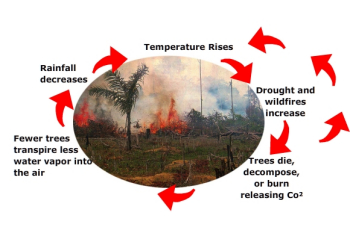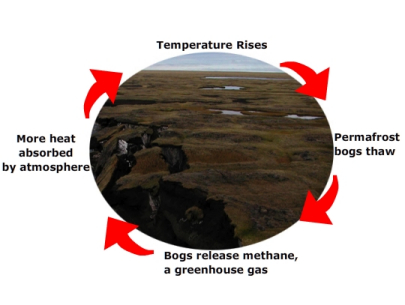2.7: Future Geographies- Feedbacks Driving Global Warming and Environmental Change
- Page ID
- 15852
\( \newcommand{\vecs}[1]{\overset { \scriptstyle \rightharpoonup} {\mathbf{#1}} } \)
\( \newcommand{\vecd}[1]{\overset{-\!-\!\rightharpoonup}{\vphantom{a}\smash {#1}}} \)
\( \newcommand{\id}{\mathrm{id}}\) \( \newcommand{\Span}{\mathrm{span}}\)
( \newcommand{\kernel}{\mathrm{null}\,}\) \( \newcommand{\range}{\mathrm{range}\,}\)
\( \newcommand{\RealPart}{\mathrm{Re}}\) \( \newcommand{\ImaginaryPart}{\mathrm{Im}}\)
\( \newcommand{\Argument}{\mathrm{Arg}}\) \( \newcommand{\norm}[1]{\| #1 \|}\)
\( \newcommand{\inner}[2]{\langle #1, #2 \rangle}\)
\( \newcommand{\Span}{\mathrm{span}}\)
\( \newcommand{\id}{\mathrm{id}}\)
\( \newcommand{\Span}{\mathrm{span}}\)
\( \newcommand{\kernel}{\mathrm{null}\,}\)
\( \newcommand{\range}{\mathrm{range}\,}\)
\( \newcommand{\RealPart}{\mathrm{Re}}\)
\( \newcommand{\ImaginaryPart}{\mathrm{Im}}\)
\( \newcommand{\Argument}{\mathrm{Arg}}\)
\( \newcommand{\norm}[1]{\| #1 \|}\)
\( \newcommand{\inner}[2]{\langle #1, #2 \rangle}\)
\( \newcommand{\Span}{\mathrm{span}}\) \( \newcommand{\AA}{\unicode[.8,0]{x212B}}\)
\( \newcommand{\vectorA}[1]{\vec{#1}} % arrow\)
\( \newcommand{\vectorAt}[1]{\vec{\text{#1}}} % arrow\)
\( \newcommand{\vectorB}[1]{\overset { \scriptstyle \rightharpoonup} {\mathbf{#1}} } \)
\( \newcommand{\vectorC}[1]{\textbf{#1}} \)
\( \newcommand{\vectorD}[1]{\overrightarrow{#1}} \)
\( \newcommand{\vectorDt}[1]{\overrightarrow{\text{#1}}} \)
\( \newcommand{\vectE}[1]{\overset{-\!-\!\rightharpoonup}{\vphantom{a}\smash{\mathbf {#1}}}} \)
\( \newcommand{\vecs}[1]{\overset { \scriptstyle \rightharpoonup} {\mathbf{#1}} } \)
\( \newcommand{\vecd}[1]{\overset{-\!-\!\rightharpoonup}{\vphantom{a}\smash {#1}}} \)
\(\newcommand{\avec}{\mathbf a}\) \(\newcommand{\bvec}{\mathbf b}\) \(\newcommand{\cvec}{\mathbf c}\) \(\newcommand{\dvec}{\mathbf d}\) \(\newcommand{\dtil}{\widetilde{\mathbf d}}\) \(\newcommand{\evec}{\mathbf e}\) \(\newcommand{\fvec}{\mathbf f}\) \(\newcommand{\nvec}{\mathbf n}\) \(\newcommand{\pvec}{\mathbf p}\) \(\newcommand{\qvec}{\mathbf q}\) \(\newcommand{\svec}{\mathbf s}\) \(\newcommand{\tvec}{\mathbf t}\) \(\newcommand{\uvec}{\mathbf u}\) \(\newcommand{\vvec}{\mathbf v}\) \(\newcommand{\wvec}{\mathbf w}\) \(\newcommand{\xvec}{\mathbf x}\) \(\newcommand{\yvec}{\mathbf y}\) \(\newcommand{\zvec}{\mathbf z}\) \(\newcommand{\rvec}{\mathbf r}\) \(\newcommand{\mvec}{\mathbf m}\) \(\newcommand{\zerovec}{\mathbf 0}\) \(\newcommand{\onevec}{\mathbf 1}\) \(\newcommand{\real}{\mathbb R}\) \(\newcommand{\twovec}[2]{\left[\begin{array}{r}#1 \\ #2 \end{array}\right]}\) \(\newcommand{\ctwovec}[2]{\left[\begin{array}{c}#1 \\ #2 \end{array}\right]}\) \(\newcommand{\threevec}[3]{\left[\begin{array}{r}#1 \\ #2 \\ #3 \end{array}\right]}\) \(\newcommand{\cthreevec}[3]{\left[\begin{array}{c}#1 \\ #2 \\ #3 \end{array}\right]}\) \(\newcommand{\fourvec}[4]{\left[\begin{array}{r}#1 \\ #2 \\ #3 \\ #4 \end{array}\right]}\) \(\newcommand{\cfourvec}[4]{\left[\begin{array}{c}#1 \\ #2 \\ #3 \\ #4 \end{array}\right]}\) \(\newcommand{\fivevec}[5]{\left[\begin{array}{r}#1 \\ #2 \\ #3 \\ #4 \\ #5 \\ \end{array}\right]}\) \(\newcommand{\cfivevec}[5]{\left[\begin{array}{c}#1 \\ #2 \\ #3 \\ #4 \\ #5 \\ \end{array}\right]}\) \(\newcommand{\mattwo}[4]{\left[\begin{array}{rr}#1 \amp #2 \\ #3 \amp #4 \\ \end{array}\right]}\) \(\newcommand{\laspan}[1]{\text{Span}\{#1\}}\) \(\newcommand{\bcal}{\cal B}\) \(\newcommand{\ccal}{\cal C}\) \(\newcommand{\scal}{\cal S}\) \(\newcommand{\wcal}{\cal W}\) \(\newcommand{\ecal}{\cal E}\) \(\newcommand{\coords}[2]{\left\{#1\right\}_{#2}}\) \(\newcommand{\gray}[1]{\color{gray}{#1}}\) \(\newcommand{\lgray}[1]{\color{lightgray}{#1}}\) \(\newcommand{\rank}{\operatorname{rank}}\) \(\newcommand{\row}{\text{Row}}\) \(\newcommand{\col}{\text{Col}}\) \(\renewcommand{\row}{\text{Row}}\) \(\newcommand{\nul}{\text{Nul}}\) \(\newcommand{\var}{\text{Var}}\) \(\newcommand{\corr}{\text{corr}}\) \(\newcommand{\len}[1]{\left|#1\right|}\) \(\newcommand{\bbar}{\overline{\bvec}}\) \(\newcommand{\bhat}{\widehat{\bvec}}\) \(\newcommand{\bperp}{\bvec^\perp}\) \(\newcommand{\xhat}{\widehat{\xvec}}\) \(\newcommand{\vhat}{\widehat{\vvec}}\) \(\newcommand{\uhat}{\widehat{\uvec}}\) \(\newcommand{\what}{\widehat{\wvec}}\) \(\newcommand{\Sighat}{\widehat{\Sigma}}\) \(\newcommand{\lt}{<}\) \(\newcommand{\gt}{>}\) \(\newcommand{\amp}{&}\) \(\definecolor{fillinmathshade}{gray}{0.9}\)In this chapter we have learned that there are two types of feedbacks, positive feedbacks that drive system change and negative feedbacks that seek to keep systems in a state of equilibrium. Geoscientists like physical geographers are recognizing that positive feedback mechanisms may drive the Earth system past thresholds and towards a new state of equilibrium. In so doing, the distribution of climates and ecosystems may be irreversibly altered and a new physical geography of the Earth system will appear.
Examples of Feedbacks Driving Global Warming
Rising temperatures are expected to cause increased evaporation of water into the atmosphere, most of which will originate from oceans. The additional water vapor boosts the absorption of infrared radiation emitted by the earth resulting in more warming (a positive feedback). The increased warmth promotes more evaporation yielding an enhanced greenhouse effect. However, the addition of water may cause an increase in cloud cover resulting in a higher atmospheric albedo and reflection of incoming solar radiation. If this were to occur, the reduction in insolation would lead to cooling. Such contradictory consequences makes it difficult to determine what actually will occur in the future.

Throughout history, humans have cut forests to build structures, warm their homes, and cook their meals, and clear the land for agriculture. Removing forests removes a powerful sink for carbon dioxide. Leaving more CO2 in the atmosphere enhances global warming and thus an increase in temperatures. As a result, temperature conditions that may be too warm to support healthy forest ecosystems. With less vegetation present, more carbon dioxide is left in the atmosphere causing more warming, another positive feedback driving the earth system toward ever warmer conditions. As temperatures increase, evaporation increases causing drier conditions and the threat of wildfires and forest destruction.

Geoscientists agree that the Arctic has been and will continue to be significantly impacted by global warming. Much of the land surface in the Arctic is underlain by permanently frozen ground called "permafrost". They uppermost "active layer" experiences seasonal thawing. Recent studies indicate that climatic warming my result in in a 12 to 15% reduction in the area covered by permafrost and a 15 to 30% increases in the thickness of the active layer. As temperature rises permafrost melts, releasing stored carbon, but just as importantly, methane. Increased warming results in more permafrost melting pushing the earth system ever forward into a future enhanced greenhouse environment.
Changes in Arctic ecosystems has already occurred as a result of global warming. Figures \(\PageIndex{3}\) a & b show two photographs from the same location in Alaska, showing the transition from tundra to wetlands over the last twenty years. When permafrost melts, water collects in small ponds on the surface increasing the heat gain nearly ten-fold. The additional heat continues to melt the underlying permafrost causing it to collapse and increasing the size of the pond. This positive feedback further degrades the permafrost.

(Courtesy: Torre Jorgenson/NOAA, Source)

(Courtesy: Torre Jorgenson/NOAA, Source)
As noted earlier in this chapter, carbon dioxide makes up a greater proportion of the atmosphere by volume, but methane absorbs energy much more efficiently. Increased warming at high latitudes may cause an increase in the release of methane from bogs or peatlands. Methane release from organic decomposition in wetlands coupled with carbon dioxide from melting permafrost will drive greenhouse gas levels higher, creating warmer temperatures.

Changes to the reflectivity of the surface (called the albedo) affects the amount of solar radiation absorb by the Earth. As Arctic sea ice melts it exposes open water which is less reflective (albedo decreases). The reduction in albedo allows more light to be absorbed by the ocean. As the ocean water warms, more heat is added to the air creating a positive feedback and driving Arctic temperatures ever higher. The reduction in sea ice is having a significant impact on arctic ecosystems.
Tipping Points and Environmental Change
Positive feedbacks drive the physical environment towards new physical states. In June of 2008, twenty years after his landmark testimony about global warming, NASA scientist Dr. James Hansen reiterated his warnings before the U.S. Congress. He cited several examples of earth systems reaching or nearing a tipping point. A tipping level (point) is a level at which "no additional forcing is required for large climate change and impacts." (Hansen, 2008). According to Hansen, a "point of no return" is reached when unstoppable and irreversible (on a practical time scale) occurs. A tipping element is a part of the earth system that has a tipping point, e.g., Arctic sea-ice loss, Sahara greening, Boreal forest dieback, permafrost and tundra loss. There is no one tipping point for the earth system as each element has its own point at which irreversible change will occur. For example, geoscientists believe that disintegration of the Greenland ice cap could occur if global temperature rises more than 2oC (3.6oF). For Arctic sea ice, the tipping point could occur with a rise of global mean temperature between .5oC (.9oF) to 2oC (3.6oF). Given the current amount of global warming, Arctic sea ice may have reached its tipping point.
Time is also an important factor in assessing whether a tipping point has been reached or a point of no return. Some, like Josefino Comiso of the NASA Goddard Space Flight Center, feel that the tipping point for perennial Arctic sea ice has already passed (National Geographic, 2007). David Barber, of the University of Manitoba is projecting that the North Pole will be ice free for the first time in history. For example, sea ice may completely disappear from the Arctic Ocean during the summer in a few years. This would represent a new state for the Arctic ocean. But temperature conditions could change in the relatively near future to permit sea ice to reform during the summer.
Assess you basic understanding of the preceding material by "Looking Back: Biogeochemical Cycles and Future Geographies" or skip and continue reading.


